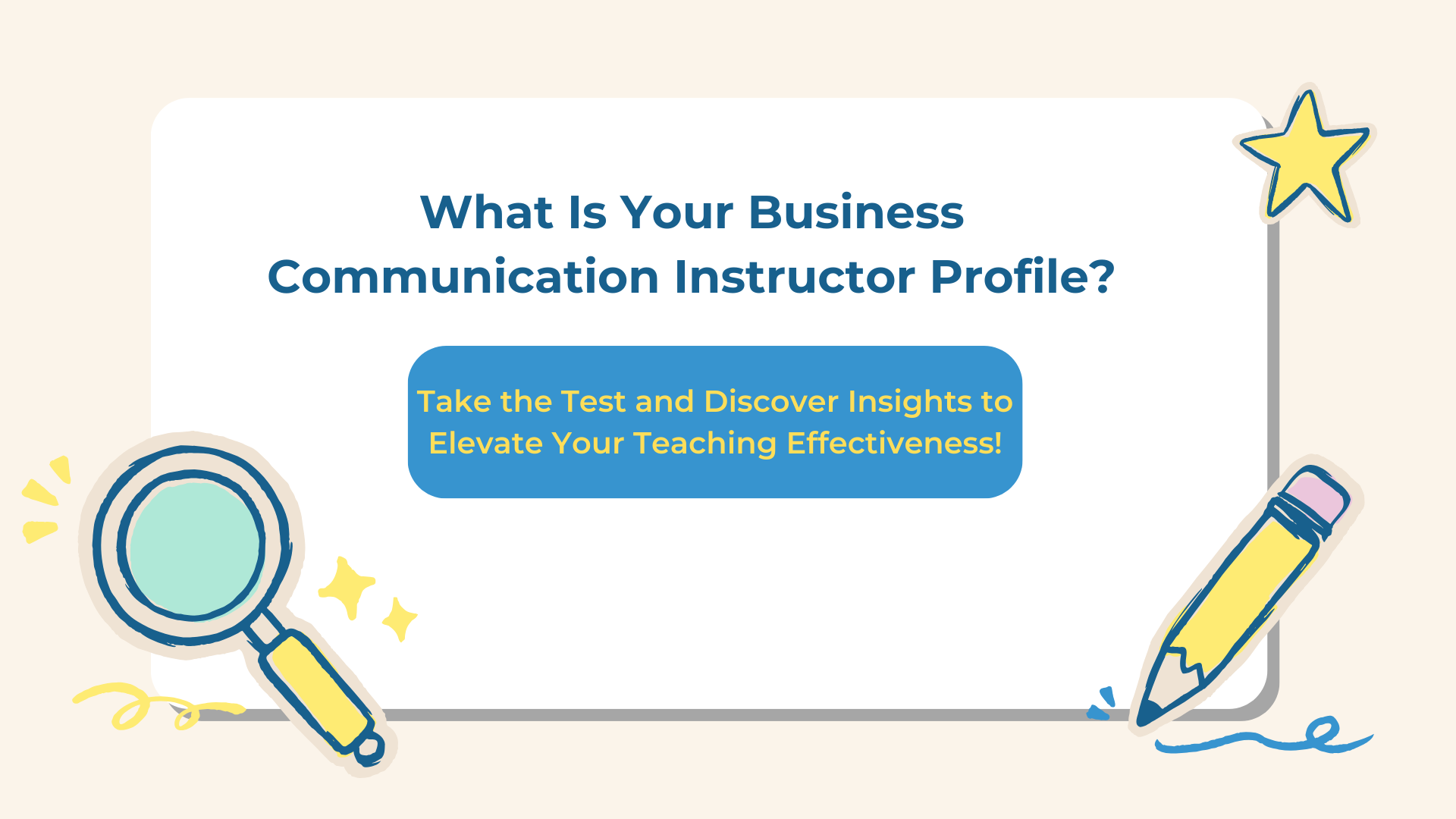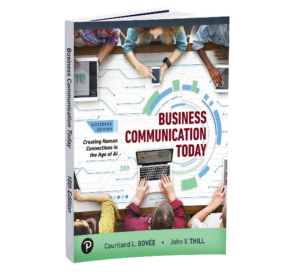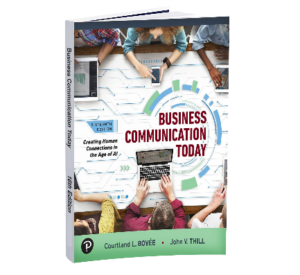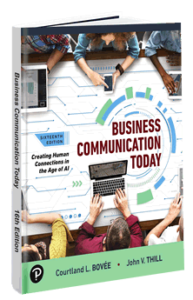
Unlock your unique teaching strengths and elevate your business communication course with personalized guidance. This concise 10-question assessment helps you pinpoint your instructional approach and highlight areas for growth. Whether you're a seasoned educator or new to the role, this tool will empower you to refine your teaching methods and better prepare your students for the demands of the modern workplace.
About This Assessment
Quick and Focused: 10 questions exploring your teaching philosophy and methods.
Immediate Insights: Receive actionable recommendations based on your responses.
Completion time: approximately 5-7 minutes
Start the Quiz Now! Write down your answer to each question.
Quiz Questions
Q1: Teaching Goals
What is the primary focus of your teaching?
A) Using cutting-edge tools like AI and social media
B) Making communication relevant to students' real-world applications
C) Building strong foundations with pre-made tools and assessments
Q2: Approach to Technology in Communication
How do you feel about integrating AI tools into your curriculum?
A) Enthusiastic—I actively teach it as part of my course.
B) Curious—I’m exploring how to best integrate it into lessons.
C) Hesitant—I prefer simpler tools that don’t disrupt traditional learning.
Q3: Curriculum Design
How often do you refresh your course materials?
A) Every semester—I seek the latest tools and trends.
B) Every few years—I focus on relevance but balance updates with consistency.
C) Rarely—I use tried-and-true resources.
Q4: Biggest Teaching Challenge
What is the most significant challenge you face in teaching business communication?
A) Keeping up with evolving technologies and trends
B) Engaging students in interactive and real-world scenarios
C) Finding reliable and ready-to-use teaching resources
Q5: Classroom Activities
What type of classroom activities do you most often include?
A) AI-driven projects and digital media assignments
B) Role-playing scenarios and case studies
C) Pre-made exercises, quizzes, and assessments
Q6: Student Engagement
How do you ensure students stay engaged with the material?
A) Incorporating digital tools and innovative approaches
B) Emphasizing real-world examples and teamwork
C) Using structured assignments with clear instructions
Q7: Real-World Applications
How do you incorporate real-world communication examples into your course?
A) Through digital media projects and AI integrations
B) By analyzing case studies and conducting interactive discussions
C) By using pre-packaged textbook examples and templates
Q8: Preferred Instructor Support
Which type of instructor support do you value the most?
A) Access to digital resources like video tutorials and AI-ready tools
B) Real-world case studies and active learning exercises
C) Pre-made test banks and lesson plans for quick implementation
Q9: Measuring Success
How do you assess whether your teaching approach is effective?
A) By how well students adapt to new communication tools and trends
B) By students’ ability to apply concepts in practical, real-world situations
C) By students' grades and performance on structured assessments
Q10: Course Objectives
What’s your ultimate objective for your students?
A) To prepare them for cutting-edge technologies and modern communication challenges
B) To equip them with practical skills for real-world business scenarios
C) To ensure they master core concepts and meet academic standards
Scoring
To determine your teaching profile, identify which letter you chose most frequently. Then, review the section below to determine your profile.
Most "A" Responses: Digital Innovation Leader
Profile: You are at the forefront of adopting new technologies. You prioritize incorporating AI tools and preparing students for future communication challenges.
Example Approach: You might use AI-powered tools to simulate real-time crisis management scenarios or client negotiations, or assign collaborative digital media projects.
Business Communication Today stands as a digital innovation leader by seamlessly integrating the latest technologies, including AI-driven communication tools and virtual platforms, into its content. It equips instructors and students with strategies for adapting to evolving communication tools such as collaborative digital media and AI-enhanced simulations. The text also emphasizes preparing students for future communication challenges, such as managing virtual teams and utilizing generative AI in content creation. By fostering digital fluency and innovation, the book ensures learners are well-prepared to navigate and lead in a tech-driven professional landscape
Most "B" Responses: Experiential Learning Guide
Profile: You emphasize hands-on practical skills and immersive learning. You aim to connect learning to real-world application.
Example Approach: You would likely use case studies and real-world scenarios followed by interactive group discussions and feedback sessions.
Business Communication Today excels as an experiential learning guide by offering a robust array of real-world scenarios, interactive case studies, and hands-on exercises. These include simulations of client negotiations, crisis communication drills, and collaborative group projects. The book emphasizes the practical application of communication principles, ensuring students connect theoretical knowledge to workplace realities. By focusing on immersive learning experiences, the text helps students develop critical skills like teamwork, problem-solving, and effective decision-making, creating a bridge between classroom learning and real-world application.
Most "C" Responses: Strategic Resource Optimizer
Profile: You rely on structured teaching resources, consistent assessments, and measurable learning outcomes. You seek high-quality materials that allow you to stay on track.
Example Approach: You'd prefer using structured lesson plans and pre-made assessments to ensure students are mastering core communication principles.
For strategic resource optimizers, Business Communication Today provides a wealth of structured resources, including customizable lesson plans, clear learning objectives, and pre-made assessments. Its focus on measurable learning outcomes allows instructors to track progress effectively while ensuring students master core communication principles. By offering concise frameworks and templates for communication tasks, the text supports efficient instruction and learning. Additionally, its emphasis on practical tools and organized content ensures students acquire essential skills systematically, maximizing teaching effectiveness with minimal preparation time.
Mixed Responses
For instructors with mixed responses across the three categories, Business Communication Today, 16th Edition offers a flexible, comprehensive approach that integrates digital innovation, experiential learning, and structured resources. The text provides adaptable tools to meet diverse instructional needs, from integrating cutting-edge AI and digital media strategies to offering immersive case studies and real-world simulations.
Simultaneously, its well-organized lesson plans and clear learning objectives ensure structure and measurable outcomes. This versatility allows instructors to customize their teaching to balance innovation, engagement, and efficiency, making it an ideal resource for varied instructional priorities
If your responses are evenly distributed or do not primarily fit one of the above categories:
Revisit your answers to identify any emerging patterns.
Reflect on your personal teaching philosophy and approach.
Business Communication Today,16th Edition provides tailored solutions for every teaching style. Contact your local Pearson representative to learn more about how Pearson can support your specific needs or visit to order an examination copy of the text.
 Rashida Tayabali
Rashida Tayabali
 NOTE: This is a summary of the chapter-opening vignette that appears exclusively in Chapter 5 of Business Communication Today, 16th Edition, by Bovee and Thill (Pearson).
NOTE: This is a summary of the chapter-opening vignette that appears exclusively in Chapter 5 of Business Communication Today, 16th Edition, by Bovee and Thill (Pearson).








